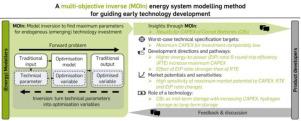A multi-objective inverse (MOIn) energy system modelling method for guiding early technology development
IF 10.9
1区 工程技术
Q1 ENERGY & FUELS
引用次数: 0
Abstract
When including emerging technologies in energy system modelling, uncertainties are inevitable in early-development technical estimations, leading to uninformative/misleading results. Knowledge of the worst, yet still viable parameter values, without extensive parameter variation, is desirable, to reconcile energy modellers’ system-level and technology developers’ perspectives. We develop a novel inverse optimisation approach, turning traditional input parameters of energy system models into optimisation variables and, hence, outputs. This addition of variables leads to a multi-objective optimisation problem, which models trade-offs between multiple interests at system vs technology level. We employ the augmented epsilon-constraint method to solve the resulting multi-objective inverse (MOIn) optimisation problem. MOIn determines worst-case technical specification targets, guides development pathways, informs about market potentials and determines technology roles. We implement MOIn in the energy system modelling framework Backbone. We demonstrate our implementation for Carnot Batteries as emerging technology in the Central Western Europe power system, inverting the capital expenditure (CAPEX) parameter, estimated from 20 €/kW/a to 913 €/kW/a in literature. We find the maximum CAPEX at which CBs are still endogenously invested is low compared to these benchmarks. As round-trip efficiency (RTE) and energy-to-power (EtP) ratios decrease, CAPEX for CBs to remain competitive becomes stricter. Increasing EtP ratios more efficiently affects CAPEX and total system cost than increasing RTEs. Further results highlight the high sensitivity of CBs’ market potential. At low CAPEX, CBs dominate as long-term storage, but are replaced by hydrogen with rising CAPEX, shifting CBs towards mid-term storage. Overall, MOIn uniquely integrates energy system modelling with technical parameter analysis, fostering collaboration.

一种指导早期技术开发的多目标逆向能源系统建模方法
当在能源系统建模中包括新兴技术时,在早期开发的技术估计中不可避免地存在不确定性,从而导致信息不足/误导性的结果。了解最坏的情况,但仍然可行的参数值,没有广泛的参数变化,是可取的,以协调能源建模者的系统级和技术开发人员的观点。我们开发了一种新的逆优化方法,将能源系统模型的传统输入参数转换为优化变量,从而输出。这种变量的增加导致了一个多目标优化问题,即在系统与技术层面的多种利益之间进行权衡。我们采用增广的ε约束方法来解决由此产生的多目标逆(MOIn)优化问题。MOIn确定最坏情况下的技术规格目标,指导开发路径,通知市场潜力并确定技术角色。我们在能源系统建模框架Backbone中实现了MOIn。我们展示了将卡诺电池作为新兴技术在中欧西欧电力系统中的应用,将资本支出(CAPEX)参数从文献中估计的20欧元/千瓦/a到913欧元/千瓦/a。我们发现,与这些基准相比,cb仍然内生投资的最大资本支出较低。随着往返效率(RTE)和能量功率比(EtP)的下降,cb保持竞争力的资本支出变得更加严格。增加EtP比率比增加rte更有效地影响资本支出和总系统成本。进一步的结果强调了cb市场潜力的高度敏感性。在资本支出较低的情况下,碳氢化合物在长期储存中占主导地位,但随着资本支出的增加,氢将取代碳氢化合物,使其向中期储存转变。总体而言,MOIn独特地将能源系统建模与技术参数分析相结合,促进了协作。
本文章由计算机程序翻译,如有差异,请以英文原文为准。
求助全文
约1分钟内获得全文
求助全文
来源期刊

Energy Conversion and Management
工程技术-力学
CiteScore
19.00
自引率
11.50%
发文量
1304
审稿时长
17 days
期刊介绍:
The journal Energy Conversion and Management provides a forum for publishing original contributions and comprehensive technical review articles of interdisciplinary and original research on all important energy topics.
The topics considered include energy generation, utilization, conversion, storage, transmission, conservation, management and sustainability. These topics typically involve various types of energy such as mechanical, thermal, nuclear, chemical, electromagnetic, magnetic and electric. These energy types cover all known energy resources, including renewable resources (e.g., solar, bio, hydro, wind, geothermal and ocean energy), fossil fuels and nuclear resources.
 求助内容:
求助内容: 应助结果提醒方式:
应助结果提醒方式:


